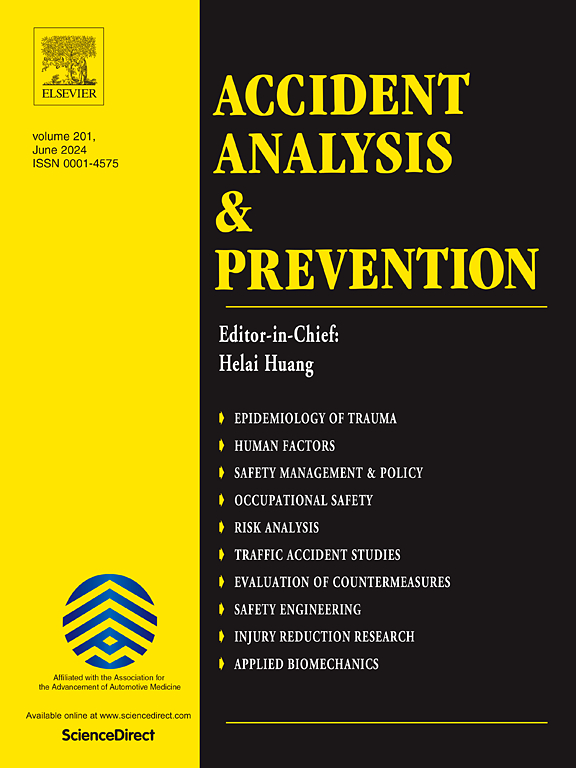REViVe:开发一种反应性环境警报车载系统,以减轻自动驾驶过程中因困倦而引起的注意力不集中
IF 6.2
1区 工程技术
Q1 ERGONOMICS
引用次数: 0
摘要
在单调或有条件的自动驾驶条件下,可能会导致驾驶员警觉性下降,增加疲劳驾驶的风险,因此实施先进的系统来帮助驾驶员恢复到最佳驾驶准备状态至关重要。虽然这些系统在降低与疲劳驾驶相关的风险方面显示出显著的效果,但大多数警告系统严重依赖听觉和视觉感官渠道。由于频繁和恼人的警报,这些模式容易受到“警报疲劳”的影响,这可能导致驾驶员完全忽略或停用系统,从而使它们不太适合先发制人的警告警告。为了解决这些限制,研究人员开发了一种车载反应性环境警戒(REViVe)系统,通过利用其他感官模式来抵消驾驶员的困倦。35名司机被分为嗅觉组、气候组和控制组。为了评估该系统的有效性,我们分析了五个相关测量指标:PERCLOS回归基线所需的时间和衡量显著效果的敬业度指数;睡意事件与外周探测任务之间的时间间隔差异测量持续唤醒效应;以及衡量司机接受程度的满意度。与控制系统相比,嗅觉和气候恢复系统都显示出有效的预警潜力。使用REViVe后,昏昏欲睡的司机很快就恢复了清醒状态,保持警觉的时间也比对照组长得多,而司机的满意度则是积极的。因此,REViVe系统为警报功能和驾驶体验提供了一个平衡的解决方案,提出了一种设计先发制人预警系统的新方法。本文章由计算机程序翻译,如有差异,请以英文原文为准。
REViVe: Development of a reactive environmental vigilance in-vehicle system to mitigate drowsiness-induced inattention during automated driving
With monotonous or conditionally automated driving conditions that may lead to the degradation of driver vigilance and increase the risk of drowsy driving, it is crucial to implement advanced systems that assist drivers in returning to a state of optimal driving readiness. While these systems have shown significant effects in reducing the risks related to drowsy driving, most warning systems heavily rely on auditory and visual sensory channels. These modalities are susceptible to “alarm fatigue” due to frequent and annoying alarms, which may lead drivers to ignore or deactivate the systems entirely, thus rendering them less suitable for preemptive cautionary warnings. To address these limitations, a Reactive Environmental Vigilance in-Vehicle (REViVe) system was developed to counteract driver drowsiness by utilizing alternative sensory modalities. A total of 35 drivers were divided into three condition groups: olfactory, climate, and control. To evaluate the effectiveness of the system, five dependent measurements were analyzed: time taken for PERCLOS to return to baseline and engagement index to measure salient effect; time interval between drowsiness events and peripheral detection task score difference to measure sustained arousal effect; and satisfaction rating to measure driver acceptability. Both the olfactory and climate REViVe systems showed potential as effective preemptive warnings compared to control. With REViVe, drowsy drivers quickly returned to an awake state and sustained vigilance significantly longer than control, while driver satisfaction was positive. Thus, the REViVe system provides a balanced solution for alert functionality and driving experience, suggesting a novel approach to designing preemptive warning systems.
求助全文
通过发布文献求助,成功后即可免费获取论文全文。
去求助
来源期刊

Accident; analysis and prevention
Multiple-
CiteScore
11.90
自引率
16.90%
发文量
264
审稿时长
48 days
期刊介绍:
Accident Analysis & Prevention provides wide coverage of the general areas relating to accidental injury and damage, including the pre-injury and immediate post-injury phases. Published papers deal with medical, legal, economic, educational, behavioral, theoretical or empirical aspects of transportation accidents, as well as with accidents at other sites. Selected topics within the scope of the Journal may include: studies of human, environmental and vehicular factors influencing the occurrence, type and severity of accidents and injury; the design, implementation and evaluation of countermeasures; biomechanics of impact and human tolerance limits to injury; modelling and statistical analysis of accident data; policy, planning and decision-making in safety.
 求助内容:
求助内容: 应助结果提醒方式:
应助结果提醒方式:


